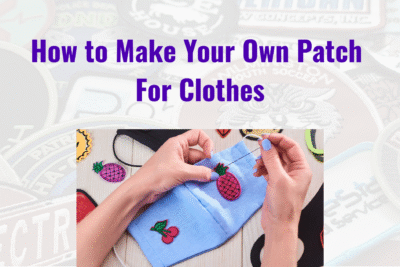How to Apply Chenille Patches? Chenille patches have become a hugely popular trend in both fashion and personal branding. Whether you’re decorating varsity jackets, backpacks, tote bags, or hoodies, these fuzzy, textured patches instantly add character and uniqueness. Their retro appeal, soft texture, and bold presence make them a favorite for students, athletes, fashion designers, and DIY lovers alike.
But once you’ve picked out the perfect chenille patch — maybe your initials, a team logo, or a cool custom design — you might find yourself asking:
“How do I apply a chenille patch without ruining it?”
Don’t worry — you’re in the right place. Whether you’re refreshing your wardrobe or branding custom apparel for a group, this comprehensive guide will walk you through everything you need to know, from prep to application to care.
Before You Apply the Patch: Prepping Is Everything
Before you iron, stitch, or glue anything, preparation is key. Taking a few moments to set things up properly will save you time and ensure that your patch goes on clean, straight, and securely. Rushing this stage is the most common reason patches fall off, get wrinkled, or look uneven.
✅ 1. Choose the Right Spot
Think carefully about where your patch should go — once applied, it’s often permanent or difficult to move. Popular placements include:
-
Upper sleeves (for a bold, classic varsity look)
-
Chest area (ideal for name initials or logos)
-
Center of the back (great for larger designs)
-
Tote bag front panels
-
Sides or tongues of sneakers
-
Baseball caps and beanies
If you’re using more than one patch, plan the layout ahead of time. Consider symmetry, spacing, and how it complements the garment’s natural shape.
✅ 2. Measure for Accuracy
If you’re aiming for a perfectly centered look — especially on clothing like hoodies or varsity jackets — always measure. Use a fabric measuring tape or a soft ruler to find the midpoint of your garment and place your patch with precision.
This becomes even more important when applying more than one patch or lining up multiple elements. Even a slight misalignment can be noticeable on symmetrical items like backpacks or jacket backs.
✅ 3. Pin It Before You Stick It
Using pins, fabric clips, or even masking tape to hold the patch in place allows you to see exactly how it will look before permanently fixing it. This step gives you the flexibility to adjust the angle or placement without committing right away.
It also helps keep the patch from sliding while ironing, sewing, or gluing — especially if the fabric is slippery or curved, like on hats or bags.
✅ 4. Clean and Dry the Surface
Patches stick best to clean, dry, and lint-free surfaces. Whether you’re ironing, gluing, or sewing, it’s crucial to wipe down the area with a lint roller or a damp cloth and let it dry thoroughly.
Any moisture, dirt, or fibers can interfere with adhesives, weaken glue bonds, or even make sewing more difficult by tangling your thread.
✅ 5. Flatten the Area
A smooth surface is essential for a professional-looking result. Lay the item on a hard, flat surface like a table or ironing board. For curved surfaces (sneakers, hats, bags), try stuffing them with socks, towels, or newspaper to create a more level workspace.
This ensures full contact between the patch and the fabric, which is critical for both adhesives and heat bonding.
How to Apply Chenille Patches (5 Proven Methods)
1. Iron-On Method (Quickest & Easiest)
Iron-on chenille patches come pre-coated with heat-activated adhesive on the back. This method is fast, simple, and ideal for thick fabrics like cotton, denim, or canvas.
Steps to follow:
-
Preheat your iron to high heat (no steam).
-
Place your garment on a flat, heat-resistant surface.
-
Position the patch where desired.
-
Cover the patch with a thin cotton cloth to prevent damage.
-
Press the iron down with firm, even pressure for 30–40 seconds.
-
Let cool, then check all edges to ensure full adhesion.
2. Sewing Method (Most Durable)
Sew On your chenille patch is the most secure, long-lasting way to apply it. It’s ideal for outerwear, sportswear, or anything that will be washed frequently.
Tips for sewing:
-
Use a needle and thread that match the patch border.
-
For machines, use a zigzag or straight stitch around the patch’s edge.
-
Hand-stitch using small, even stitches within the black outline.
3. Fabric Glue (Easy, But Not for Heavy Use)
For fashion pieces or temporary decor, fabric glue is a convenient no-sew option.
How to apply:
-
Lay the patch face down.
-
Apply a thin, even layer of glue on the back.
-
Place it on the fabric and press down for 30 seconds.
-
Let dry for 1–2 hours before wearing.
4. Double-Sided Fabric Tape (Temporary & Reusable)
Need your patch for an event, costume, or short-term outfit? Fabric tape is a fast and temporary solution.
-
Cut tape to match the patch’s shape.
-
Stick it on the back and press the patch into place.
-
Remove and reposition as needed.
5. Velcro (For Swap-Friendly Patches)
Want to change up your patches frequently? Velcro is perfect for tactical gear, hats, and uniforms.
-
Attach the hook side of Velcro to the back of your patch (using glue or sewing).
-
Attach the loop side to the garment.
- Press firmly together — and swap patches anytime!
Ready to Bring Your Custom Chenille Patch to Life?
A chenille patch is more than just a design — it’s a statement. Whether you’re celebrating achievements, expressing your style, or customizing brand apparel, applying it the right way ensures a polished and long-lasting look.
.At Elegant Patches, we specialize in creating fully customized chenille patches with unmatched quality, bold colors, and expert craftsmanship. Whether you’re ordering for a team, brand, school, or just for yourself, we’re here to help you turn your idea into a tactile masterpiece.





